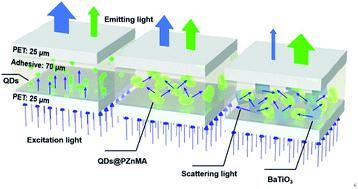Our official English website, www.x-mol.net, welcomes your
feedback! (Note: you will need to create a separate account there.)
Enhanced light emission of quantum dot films by scattering of poly(zinc methacrylate) coating CdZnSeS/ZnS quantum dots and high refractive index BaTiO3 nanoparticles
RSC Advances ( IF 3.9 ) Pub Date : 2020-8-28 , DOI: 10.1039/d0ra05389a Hongcheng Yang 1, 2 , Miao Zhou 3 , Haodong Tang 1 , Mingyu Sun 1 , Pai Liu 1 , Yizun Liu 2 , Lixuan Chen 3, 4 , Dongze Li 3 , Dan Wu 1 , Junjie Hao 1, 2 , Bing Xu 1, 2 , Zhili Zhao 1 , Zhenwei Ren 1 , Siqi Jia 1 , Kai Wang 1 , Xiao Wei Sun 1
RSC Advances ( IF 3.9 ) Pub Date : 2020-8-28 , DOI: 10.1039/d0ra05389a Hongcheng Yang 1, 2 , Miao Zhou 3 , Haodong Tang 1 , Mingyu Sun 1 , Pai Liu 1 , Yizun Liu 2 , Lixuan Chen 3, 4 , Dongze Li 3 , Dan Wu 1 , Junjie Hao 1, 2 , Bing Xu 1, 2 , Zhili Zhao 1 , Zhenwei Ren 1 , Siqi Jia 1 , Kai Wang 1 , Xiao Wei Sun 1
Affiliation

|
Quantum dots (QDs) have received considerable attention in information displays owing to their high quantum yield, high colour purity and low-cost fabrication. However, light emission for ultra-thin QD films with low mass percentage of QDs still need to be improved because the blue light can directly transmit the films, leading to insufficient energy to excite the QDs. In this study, we report QD films based on a poly(zinc methacrylate) coating with alloyed green-emitting CdZnSeS/ZnS quantum dots (QDs@PZnMA) together with high refractive-index BaTiO3 nanoparticles to enhance the scattering coefficient of the QD films. Results demonstrate a 7.5-fold increase in the absorption coefficient, 11.3-fold increase in the scattering coefficient, 8.5-fold increase in the optical density (OD) and 8.6-fold increase in the green-light emission of QD films, compared with films that have the same mass percentage of pristine QDs. This approach provides a promising strategy for developing QD optical films with high scattering and enhanced light emission for flexible displays.
中文翻译:

通过聚(甲基丙烯酸锌)涂层 CdZnSeS/ZnS 量子点和高折射率 BaTiO3 纳米粒子的散射增强量子点薄膜的发光
量子点 (QD) 因其高量子产率、高色纯度和低成本制造在信息显示领域受到了广泛关注。然而,由于蓝光可以直接透射薄膜,导致QDs激发能量不足,QDs质量百分比低的超薄QD薄膜的发光仍需要改进。在这项研究中,我们报告了基于聚(甲基丙烯酸锌)涂层的量子点薄膜,该涂层具有合金的绿色发光 CdZnSeS/ZnS 量子点 (QDs@PZnMA) 以及高折射率 BaTiO 3纳米粒子增强量子点薄膜的散射系数。结果表明,与薄膜相比,QD 薄膜的吸收系数增加了 7.5 倍,散射系数增加了 11.3 倍,光密度 (OD) 增加了 8.5 倍,绿光发射增加了 8.6 倍具有相同质量百分比的原始量子点。这种方法为开发用于柔性显示器的具有高散射和增强光发射的量子点光学薄膜提供了一种有前景的策略。
更新日期:2020-08-28
中文翻译:

通过聚(甲基丙烯酸锌)涂层 CdZnSeS/ZnS 量子点和高折射率 BaTiO3 纳米粒子的散射增强量子点薄膜的发光
量子点 (QD) 因其高量子产率、高色纯度和低成本制造在信息显示领域受到了广泛关注。然而,由于蓝光可以直接透射薄膜,导致QDs激发能量不足,QDs质量百分比低的超薄QD薄膜的发光仍需要改进。在这项研究中,我们报告了基于聚(甲基丙烯酸锌)涂层的量子点薄膜,该涂层具有合金的绿色发光 CdZnSeS/ZnS 量子点 (QDs@PZnMA) 以及高折射率 BaTiO 3纳米粒子增强量子点薄膜的散射系数。结果表明,与薄膜相比,QD 薄膜的吸收系数增加了 7.5 倍,散射系数增加了 11.3 倍,光密度 (OD) 增加了 8.5 倍,绿光发射增加了 8.6 倍具有相同质量百分比的原始量子点。这种方法为开发用于柔性显示器的具有高散射和增强光发射的量子点光学薄膜提供了一种有前景的策略。

















































 京公网安备 11010802027423号
京公网安备 11010802027423号